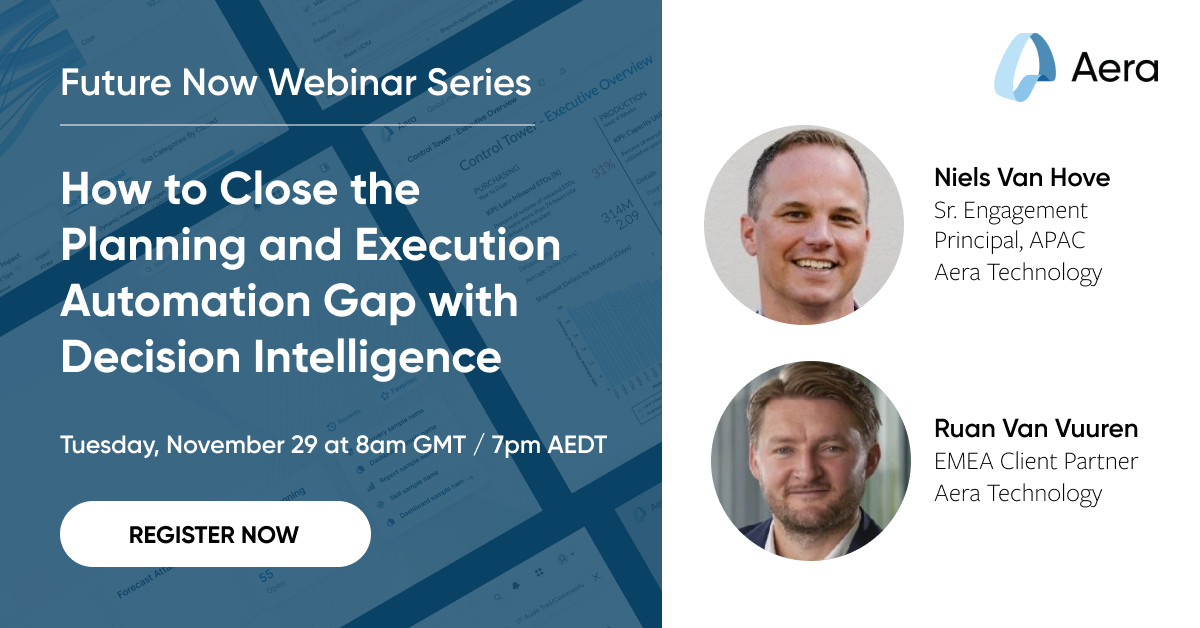There was a lot of interest and commentary on my last post on the Automating of Routine Collaborative Decisions in S&OE. So much that I decided to do a webinar with my colleguae Ruan Van Vuuren.
Especially the below schematic got a lot of reactions. It shows for a large global beverage business, what decisions could be automated in the S&OE horizon. Although for every industry and business it has to be assessed what decisions could, should, or should not be automated, it is a very good conversation starter.
It also requires a shift in mindset and some self-reflection
It requires to ask yourself the questions. What am I good in that a machine can’t do? What could the machine do better, faster, more accurate, at a larger scale than me? As Kasparov said: “This is a new form of collaboration where we recognize what we’re good at and not interfere with machines where they’re superior… …even if it hurts our pride.”

The planning & execution automation gap left on the table by APS and BI in the last 20 years is enormous. The supply chain planner uses better systems than 20 years ago for sure, but compared to the automation of the physical supply chain, the automation of planning & execution tasks and decisions has stayed behind dramatically.
Having worked since 2000 with APS, implementing it in over 15 countries for global companies and conducting many system selections for clients, I really believe intelligent automation can close this gap.
Decision Intelligence creates a more efficient & resilient supply chain for sure. But maybe more important, it will automate the boring, frequent, repetitive, decisions and actions, enabling the planner to focus on value add and strategy.
A win-win!
Join me and my colleague Ruan Van Vuuren in our upcoming webinar on Nov 29th, where we will discuss this in further detail.
Hope to see you there


That is it, nice and cool !!
Data quality, just add it to this process (Execution, S&OE, IBP, APS), because if it was not addressed the process will fail.
Cheers,
Thanks Stefano,
you are right, data is important. We also have to watch out that it is not an easy excuse to stick to the status quo.
Doing nothing becuase a general statement ‘we don’t have accurate data’ is a cop out to me.
As Lorien Pratt says; ‘Data, technology & AI must take a back seat to dilligent understanding of the decisions they support
We need to be more specific; what data do we need for decisions & actions & what data is not accurate?
1. 90% of predictive value sits in 10% of your data. So understanding what data to focus on is important. Not all your data needs to be in good shape. It’s a waste of time to cleanse all your data. Spend it on data that support decisions & actions.
2. Many supply chain decisions & actions don’t need big data or ML to make good decisions. Small data & simple logic will do just fine for many many use cases
3. Business make decisions and actions with their current data, so why not make better & faster decisions and actions with your current data?
4. There are already ways to automatically cleanse and maintain data, so make that part of your automaton strategy for important data
Great, agree, however continuous improvement culture should be part of the organizations, companies, life, anyway, so to begin the journey as I said, agree, however continuous improvement culture brings maturity to the process and to the business and to the digital transformation and it is more than just supply chain, so again agree and let us move on.
Good job done !!
You are welcome, cheers !!!
I am unable to register for webinar as it is asking for business email id . However, I am working as independent freelance consultant and hence I have my personal email id only. Requesting to please allow me to register for webinar (current and in future also) with my personal mail id. Thank you
Unfortunately, it only works with a business email.